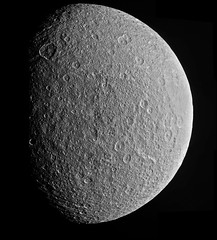Cassini is soon to commence equatorial phase 2 of the XXM, following a nudge by Titan on March 16th, with consequent opportunities for further close encounters with Saturn's icy moons and 'rock-moons'
The 'looking-ahead' article for the next orbit has just been published - link here Cassini will be taking a couple of mosaics of Rhea at half-phase on February 10th as a foretaste of what's to come.
The article states that this is "the first of 20 targeted and non-targeted flyby of icy satellites (moons other than Titan) this year where ISS [the optical telescopes] will be acquiring images, and the only one of Rhea"
This leaves a further 19 close encounters where images will be taken at or around closest approach to various of the remaining moons, and I wondered which ones would be given priority.....
Using that other excellent resource, Emily L's 'tour of the Saturn system' blog article yields a number of possibilities for those remaining imaging encounters.
The following are targeted encounters and will definitely involve imaging although not necessarily at closest approach:
Dione June 16th - altitude 516km
Dione August 17th - altitude 474km
Enceladus October 14th - altitude 1839km
Enceladus October 28th - altitude 49km (closest remaining flyby)
Enceladus December 19th altitude 4999km
That leaves 14 non-targeted (i.e. fortuitous) encounters for 2015 and there are a host of tempting targets:
N.A.C. = Narrow angle camera
F.O.V. = field of view
Tethys April 11th 52867km
Telesto May 9th 46451km (86 NAC pixels across disc at c/a)
Polydeuces May 10th 34028km (17 NAC pixels across) closest remaining encounter of the mission
Hyperion May 31st 34287 (closest remaining encounter in the mission, Hyperion will be larger than the NAC F.O.V at c/a)
Telesto June 16th 44150km (91 NAC pixels across)
Polydeuces June 16th 34757km (17 NAC pixels across)
Telesto July 5th 14165km (282 pixels)
Dione July 27th 60520km
Tethys August 17th 41892km
Enceladus August 18th 53165km
Dione September 8th 41945km
Dione September 30th 40820km
Calypso September 30th 40820km - closest remaining encounter
Mimas September 30th 64791km
Telesto October 28th 59688km (89 pixels)
Tethys November 11th 8356km closest remaining encounter
Tethys November 23rd 17519km
Epimetheus December 6th 2616km (fills the NAC F.O.V.) closest remaining encounter
Atlas December 6th 20857 (256 pixels ) 2nd closest remaining encounter
Prometheus December 6th (714 pixels ) closest remaining encounter
Aegaeon December 19th 2556km (33 pixels ) closest remaining encounter
I can't find any information regarding Anthe but it's so small, it seems unlikely any useful images will be attainable for this little moon.
I think Hyperion is perhaps a certainty, and the two close Tethys passes also.
Anybody have any preferences? Mine are Aegaeon (likely I think considering the range) Atlas, Polydeuces and Epimetheus.
Full Version: Equatorial phase two
Unmanned Spaceflight.com > Outer Solar System > Saturn > Cassini Huygens > Cassini's ongoing mission and raw images
And many more starting here.

A little Rhea back and forth gif.
...oh, my.  Those are beautiful, EB! Sharp right down to the limit of resolution.
Those are beautiful, EB! Sharp right down to the limit of resolution.
These images give me the impression that Rhea is much more heavily cratered than airless worlds in the inner Solar System, mostly because craters of all sizes seem fresher in appearance. Does this imply that micrometeoritic erosion is much less active out there? Rhea clearly doesn't get much ring material deposition.
These images give me the impression that Rhea is much more heavily cratered than airless worlds in the inner Solar System, mostly because craters of all sizes seem fresher in appearance. Does this imply that micrometeoritic erosion is much less active out there? Rhea clearly doesn't get much ring material deposition.
Beautiful images!
This is a "lo-fi" version of our main content. To view the full version with more information, formatting and images, please click here.


